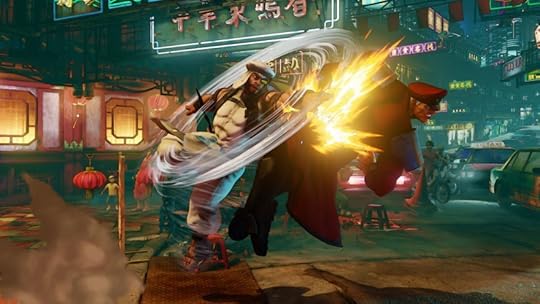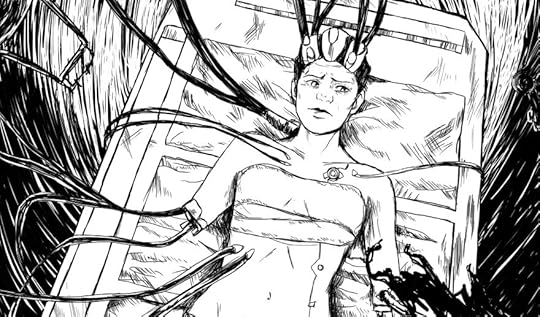Kill Screen Magazine's Blog, page 126
May 4, 2016
How computers find naked people
We are all just collections of limbs and appendages, naked before the Internet. Some of us—or some of our devices—just may not know this yet. Curiously, it’s our devices that lag that lag behind in this regard. The Internet, as was correctly noted in Avenue Q, may be for porn, but identifying nudity is not technology’s forte. As such, content moderation is still a tedious human labor, and as Adrian Chen documented in his excellent 2014 Wired feature, it’s a soul-crushing search for dick pics—among other things.
So, here we are. It’s 2016, and as Clarifai “data scientist and NSFW enthusiast” Ryan Compton (yes, that’s his title) puts it: “the discovery of nude pictures has been a central problem in computer vision for over two decades. Potter Stewart’s “I know it when I see it” maxim doesn’t apply to technology. Devices don’t really see things—not in any conventional sense. Computers can recognize patterns, but that raises the question of what nudity looks like as a pattern. Humanity, as anyone with an Internet connection can tell you, has conjured all sorts of imaginative ways of being nude, so good luck with that one.
it is simply projecting human mores onto images
Early approaches to nudity pattern recognition, Compton notes, searched for large stretches of skin-toned colors in images and then sought to narrow down the field by further focusing on limb-like shapes. This technique, outlined in the wonderfully titled academic text “Finding Naked People,” worked a little more than half the time. The more recent (and seemingly effective) approach that Compton identifies teaches artificial intelligence to recognize “not safe for work” (NSFW) imagery from historical patterns as opposed to strict prescriptions. (Clarifai works in the artificial intelligence space and if you want more technical details, their blog post is a great resource.) In short, the system “correctly learned penis, anus, vulva, nipple, and buttocks—objects which our model should flag.”
 Is this not safe for work?
Is this not safe for work?This model of NSFW content appears to be effective, but it carries with it much of the baggage of human moderation. After all, the term ‘not safe for work’ is more of a moral judgment than an objective determination. If the AI learns that red lips are indicators of more adult content, which they apparently are, it is simply projecting human mores onto images. Similarly, one cannot expect deep learning or AI to solve the running problem of social networks treating breastfeeding as sexual content. (That is also to say nothing of the double standards for male and female bodies.) Technology can make content moderation easier, but it can’t fix our deeper, more human struggles with the naked human form.
New visual novel should satisfy your lo-fi cyberpunk dreams
New York City has a clichéd nickname: The City that Never Sleeps, referring to the restlessness of nightlife in the city. Similar is the metropolis in the newly released Cyber City 2157: The Visual Novel, as it also never sleeps. But that’s because the sun never sets. Night never comes to toss its dark cloak over the city. The City (capitalized, as it is a character in itself) remains bright, shining, always ready to adventure—it doesn’t sleep because it doesn’t get a chance to. And you, the player, are tasked with navigating all its parks, suburbs, cemeteries, and even dreams.
Created by Harotobira, Cyber City 2157 is, as written in its full title, a visual novel. It’s also an exploration of the fundamentals of mysticism and cyberpunk, inspired by postmodern literature and arthouse films. Cyber City 2157’s arthouse inspirations are at the forefront, with its lo-fi, forever-obscured backgrounds. The visual novel never cops to an anime-inspired aesthetic as so many others in the genre adhere to. Instead, it waives those trappings and ventures more into a Twine-like territory of narrative and choice.
In Cyber City 2157, you’re tasked with remembering a long-forgotten dream. As you wander towards an unknown future at work creating Molds—”perfect” human simulations that sound eerily similar to Blade Runner’s (1982) replicants. The dream is fragmented. There’s the abyss of the cosmos, a frightened astronaut, and that’s all you remember. Cyber City 2157 is about recollecting that dream, and finding your own place in the City itself, as you reside in a reality that changes far too rapidly to even comprehend.
Get a grip on lo-fi reality, as Cyber City 2157: The Visual Novel is out now on Steam for $5.99 , available on PC and Mac.
You can visit an historically accurate 1920s Berlin in Second Life
In 2007, Jo Yardely visited Second Life (2003) for the first time. She looked around, took in the view, and left immediately. “[Second Life] was a place where weird people spent all their time chatting about uninteresting things,” she said on her blog, “pretending they were having virtual hanky panky or spending real money on virtual rubbish.” You risked being griefed. Most of the simulations looked “horrendous.” Everyone’s fashion sense was terrible.
Nine years later, Yardley runs one of the most successful historical simulations in Second Life. Her version of 1920s Berlin has over 100 tenants and regularly hosts events that would have taken place in the real Berlin during the time period, such as cabaret shows at the Eldorado Cabaret or dinner at the Hotel Adlon. She’s meticulously recreated the Zum Nußbaum restaurant, simulated complicated legal changes to German drug laws, and even collected enough money to sponsor a Stolperstein (stepping stone) that is a real-life memorial to Nazi victims. At the beginning of May, she’ll lead a reenactment of the 1929 May Day riots; sort of like Civil War reenactments, but you’re not required to be outside.
Her project has been going strong since she first slapped a couple textures together in 2009, but it got a fresh look in the media when machinima maker Pepa Cometa created a beautiful video of the Berlin project last month. Her video was seen 10,000 times in two weeks, and Yardley’s project was mentioned on German talk show “Volle Kanne” as well as written about at The Creators Project. As Yardley intended, her Berlin is faithful and gorgeous, with signs advertising tea at eleven (Elf Uhr Tee) and protesting eviction (Gegen Delogierung!). Children in period clothing wander the streets to the sounds of Marlene Dietrich and, in a quiet park, the sun breaks through gentle clouds just as it would in real-life Germany.
One well-crafted simulation doesn’t cancel out all of the bizarre and terrible things that go in in Second Life, but it’s still a strong vote in its favor. A place as beautiful as Berlin can go a long way in convincing even the most doubtful skeptics that Second Life, for all of its “virtual rubbish,” can do some pretty cool things after all.
Travel back in time to Berlin in Second Life , and learn more about the project on Yardley’s blog and the project’s homepage .
Koi brings the tranquility of a Chinese lotus pond to your PS4
Chinese studio Dotoyou recently released its game Koi on the PlayStation 4, making it the first game from its native country to be released on the PlayStation 4 in the West.
Koi stars a koi fish facing dangers beneath the surface of its resident lotus pond, such as predator fish and spiked barriers. By causing flowers to bloom, the titular koi can “purify” the pond, turning the predators into friends and cleaning the waters. DAQ, Dotoyou’s lead designer, told me the idea for the game originally came from the team’s love of animals and their respect for their environment. “We combined this idea with our experiences and thoughts about what it means to express a large idea using smaller concepts,” he said.
“we want players to feel what we call ‘lingqi’ or insight and realization”
With Koi, Dotoyou is hoping to give players a bit to think about—like the effects of pollution. “[O]ur hope was that by making it the inspiration for the storyline, players would take a moment and reflect on this very important situation that is harming the existence of our planet— providing the opportunity to open up a larger conversation on this topic,” Dotoyou CEO Julien Li said.
Furthermore, the studio wants players to experience a range of emotions playing Koi. DAQ explained, “Through experiencing the fish, flowers and water in-game, we want players to feel what we call ‘lingqi’ or insight and realization—something that’s special, spiritual, beautiful and out of the ordinary.”
Being the first Chinese team to have released a PlayStation 4 game in the West is a very exciting feat for the team. “We feel it’s pretty miraculous, and it’s something of a milestone in Chinese gaming history,” Li said.
DAQ mirrors this excitement, adding that Koi is a chance for Western players to become familiar with a game from China. “We believe that, after us, there will be tons of other console games that will be appearing on the televisions of gamers all over the world,” he said. “This kind of trend, a trend in which the culture of gaming becomes more open and versatile, is something which we really look forward to.”
Koi is available now for the PlayStation 4. More information on the game can be found at its website.
Where Did The Fun Street Fighter Music Go?
My anticipation for the recently released Street Fighter V probably came from a different place than most people. I’ve only ever really followed the series as an observer who watches tournament matches, and as a listener of the games’ soundtracks. For me, then, Street Fighter V’s release held two possibilities: new tournament material after eight years of Street Fighter IV (2008) and its iterations, and new music. Whatever you think of the mechanical changes and viability of certain characters, Street Fighter V is sure to offer a lot of the former for passive appreciators like myself. As far as the latter goes, there’s not much to say. Not much that’s positive, anyway. And that’s frustrating.
easily among the funnest music the medium has ever produced
The Street Fighter series once harbored some of the most electrifying and colorful music put to videogames, crafted by some of the industry’s best musicians. The now-iconic themes of characters like Ken, Guile, and Ryu from Street Fighter II (1991), for example, were written by Yoko Shimomura, the composer behind the upcoming Final Fantasy XV and the bizarrely beloved trainwreck that is the Kingdom Hearts series. There was also a willingness to musically experiment with the series’ stylistic identity. As much as I think Hideki Okugawa’s Street Fighter III: 3rd Strike (1999) soundtrack would be way better off if it were complemented by hip-hop lyrics, there is something to admire in the contrast between its gravelly, jazzy, drum-and-bass flavor and the clear melodic approach of Street Fighter II.
It’s unfortunate that the series hit a musical high point with the Street Fighter EX titles. These are the spin-offs nobody wants to play, at least on a professional level. The EX games precede Capcom really figuring out how to make a convincing leap from 2D to 3D; they don’t have the speed, precision, or bite of a game like 3rd Strike. This deficiency, plus the fact that the games were spin-offs to begin with, and phenomena such as Guile’s Street Fighter II theme becoming an internet meme, have combined to bury the EX soundtracks below the cultural surface.
Dig them up, though, and you’ll find a treasure trove. These scores composed by Shinji Hosoe, Ayako Saso —both of whom, along with Yousuke Yasui, composed what is secretly the best Mega Man soundtrack for Mega Man Network Transmission (2003)—Takayuki Aihara, and Yasuhisa Watanabe, overflow with vibrancy, weirdness, and humor. Theremin-like leads belt out lyrically and melodramatically, elastic slap basses bounce around, and oblique chords get themselves into the oddest positions. It’s easily among the funnest music the medium has ever produced.
Disappointing, but predictable
Street Fighter has always had an inherent element of humor, partly derived from its campy thematic dissonances. Just look at and compare the character designs—a stoic man in a karate gi matched against a green-skinned, shark-toothed,carrot-topped humanoid—or consider how the main antagonist’s criminal organization is called Shadaloo. The progressive deterioration of that element is disappointing. Now, the humor (if it can be called that) of Street Fighter music seems to be limited to boring, braggy, “promotional” vocal tracks—Street Fighter IV’s “Indestructible” and Street Fighter V’s “Survivor”—which are presented with an undeserved sobriety.
Disappointing, but predictable. When Capcom released Marvel vs. Capcom 2 in 2000, all reviewers could do in response to its joyfully irreverent lite-fusion soundtrack was angrily wonder why the composers complemented a goofy videogame—full of ridiculous musclemaniacs slamming one another sky-high—with goofy music. This might’ve been one of the interactions that helped to set Capcom on the course they are on now: the territorial and myopic portion of an audience (the fanatics, in other words) gradually influencing the movements of a creative body for the worse. Why are the themes for Ryu, Ken, or Vega in Street Fighter IV and Street Fighter V arrangements of their Street Fighter II themes? Because the hivemind has demanded it be so by fetishistically enshrining that entry, similar to The Legend of Zelda series and Ocarina of Time (1998). Any major deviation from that standard will be taken as a betrayal of the “franchise’s core principles.”
Street Fighter IV and V’s spiceless soundtracks are representative of something more depressing to me, though, and that’s the escalating westernization of the industry and its inferiority complex relative to cinema and popular culture in general. Japan’s videogames have always been obsessed with Europe and North America—the long-running Dragon Quest series, for example, has its indebtedness to western fantasy right in its name—but what made this obsession charming were the eccentricities and surprising combinations, the actually vital contrasts, that came from a culture playing with “exotic” elements. Ergo, Castlevania: Rondo of Blood’s (1993) upbeat synth-pop soundtrack, the colorful robustness of Dungeons and Dragons: Shadow Over Mystara’s (1996) character designs, or Earthbound’s (1994) peculiar interpretation of an American town.
As the medium has exploded in popularity and its big names have hailed increasingly rarely from Japan, many Japanese developers have either attempted to integrate themselves into that shift or compete with it by producing material that plays its westernness much more straightly. Capcom’s Dragon’s Dogma (2012), for example, takes more of its formal cues from Bethesda’s The Elder Scrolls IV: Oblivion (2006) than it does from Shadow Over Mystara (also by Capcom). And the soundtrack to a game like Castlevania: Lords of Shadow (2010)—Konami handed this one over to the Spain-based developer MercurySteam—exemplifies that aforementioned inferiority complex, intending to impress on the basis of sounding “like a movie score.” We hired a real composer and employed a real orchestra!
an aural swamp that seems to have been produced with the primary goal of being loud
Street Fighter V’s soundtrack isn’t as much an annoying attempt at cinematic gravitas (it is, a little) as it is the most conservative sort of populism, continuing where Street Fighter IV left off. Nearly every track is an obvious and embarrassing grab at commercially viable epicness: a synthetic orchestral ensemble, for the classiness, paired with electro/dubstep elements and maybe an electric guitar, for the coolness. It sounds like a standard playlist assembled from OCRemix’s tepid bowels, or library music used for the transitional parts of a television show about hot rods—not a fresh and powerful score for a mainstay series. And as bland as the melodies are, they’re made all the more forgettable by a scarcity of unique lead instruments and mixing that sounds as if the controls on the console were all left in the center positions.The result is an aural swamp that seems to have been produced with the primary goal of being loud.
Karin’s theme stands out for not trying to destroy your ears, and the brief appearance of a cute, bubbly mono-synth that actually complements its melody’s doodling contours. Its dated and flimsy violin synth takes up too much space, though, and just makes me wonder why Capcom isn’t hiring performers to play instruments that are trickier to emulate. A lot of people seem to like Rashid’s theme, but that’s because its cries of the character’s name set to dubstep easily appeal to an internet culture hungry for one-note memes that can be used in YouTube videos.
I see another missed opportunity here, and it’s that an unconventional and fun soundtrack might’ve actually been the push that I, and maybe a quiet minority, needed to get into Street Fighter V. It’s no exaggeration to say that I played Virtua Fighter 5: Final Showdown (2010) for as long as I did because it was possible to replace the default soundtrack with Virtua Fighter 3’s (1996). Music has always been an ingredient that’s convinced me to invest more of myself in a movie, show, or videogame than I otherwise would, or to even pay attention at all. I don’t want a videogame where I turn the music down and play my own on a pair of headphones. I want to develop a bond with something based on its native traits. I want to feel as enthused by as much of the game as possible.
For a while, videogames—especially those coming out of Japan—were the site of some of the most exciting musical developments, period. Free from the demands of radio, there was no real concern about the music’s presentability on a mass-cultural level. And when rendered in the vocal chords of arcade cabinets, consoles, and handhelds, Japanese composers’ reinterpretations of western musical forms were all the more alluring. Even after certain technological limits were outgrown, soundtracks like the Street Fighter EX games’ expanded on those eclectic values: hugely inspired by jazz fusion and Yellow Magic Orchestra, yet avoiding any neat or plain labels. In reflecting on Street Fighter V’s musical deficiencies, we can at least be compelled to highlight the preceding creativity before it’s entombed by an increasingly normalized canon.
May 3, 2016
Deal With It bot lets you put a pair of virtual shades on anyone
Is there anything cooler than sunglasses? Yes. Leather jackets. That one sword move from Shinobi. Anything but vaping. But sunglasses are still pretty high up there.
Inspired by the meme of the same name, the Deal With It bot is a simple web application that takes any photo of one or more faces and animates a pair of sunglasses coming from top of frame to cover their eyes, followed by text that says “DEAL WITH IT.” It works with both solo and group shots, but is unfortunately limited to pictures of real, human people, meaning that cartoon characters like Kermit the Frog and Inspector Gadget won’t work, and neither will animals (I tried). The animations are then hosted on the site, which users can easily link to through Twitter.
Need an example? Here’s perpetual sadboy Drake rocking a pair of classic black shades.
But we can do better. Here’s Drake and Kanye (DraKanye) together:
Here’s one where Drake was already wearing sunglasses:
The bot is more than just a “try your damndest to make Drake cool for once” app, of course, and can easily be used to create new profile pictures or, for the brave, high school yearbook photos. It comes our way from FEMICOM museum founder Rachel Simone Weil, whose previous work includes hacking classic titles like Mega Man 2 (1988) to give them a more feminine makeover and curating museum exhibitions of old school games and toys aimed at girls.
As of now, there’s no way to save the generated images directly to a computer without using screen capture software, but that’s a small price to pay to be able to reach this level of radical:
You can check out the Deal With It bot over on its website, and can follow its creator over on Twitter.
Looking back at the Met Gala’s evening of technology-age fashion
Fashion, like everything else in the age of technology, is about fear—fear of what is coming next; fear of looking silly in the long run; fear of trying something new. How else to explain the often-underwhelming interpretations of “Manus x Machina: Fashion In An Age Of Technology” theme for last night’s Costume Institute Gala at the Metropolitan Museum of Art? Technology is complicated, and a little scary.
To be fair, dodging the theme is a Met Gala tradition. Like a Top Chef contestant who can turn any prompt into a crudo, designers will always find ways to subvert the event’s theme. But the peculiar failings of this year’s Met Gala are particularly instructive, because the Manus x Machina prompt at least raises an interesting question: What does fashion look like in an age of technology?
All ages are ages of technology in their own ways. The invention of the wheel, for instance, ushered in an age of technology. So, too, did the printing press. Lord only knows Downton Abbey is a show about living in an age of technology. Thus, one supposes, this is on theme:
A rosy @blakelively and @Burberry's Christopher Bailey just arrived to the #MetGala. pic.twitter.com/KIsU9aNKC1
— Vogue Magazine (@voguemagazine) May 3, 2016
But let us briefly suppose that “Fashion In An Age Of Technology,” though not the most precise of descriptors, actually has some meaning. (In the case of the actual Met exhibit being unveiled, it refers to fashion since the 19th century, encapsulating the field’s evolution since the sewing machine disrupted hand-made couture and offered different modes of production.) The subject presupposes that technology seeps into every crepuscule of our lives; it’s technology’s world and fashion is just living in it. How, then, to reconcile technologies of the future with designs that nod to couture’s past. Apparently, the answer to this question is to ape Fritz Lang’s Metropolis (1927)—one of those brief, iconic moments where futurism was actually wearable and overlapped with design in a way that no Google Glass, Apple Watch, or VR headset has yet to do. In other words, this:
Jordan Dunn. One of the very few who understood the theme, and killed it. #MetGala #MetGala2016 pic.twitter.com/g6jZd72Syj
— Beauty in Color (@PoCBeauty) May 3, 2016
Just wait—@KimKardashian and @kanyewest are about to step onto the #MetGala red carpet. pic.twitter.com/FTzjDADrIS
— Vogue Magazine (@voguemagazine) May 3, 2016
Or, if you’re Taylor Swift, the answer to this question is what might generously be described as “goth Metropolis???”:
Co-chair and Vogue cover star @taylorswift13 has arrived in a short, sequined minidress: https://t.co/zYg3zmY8IN pic.twitter.com/Ywv32D697w
— Vogue Magazine (@voguemagazine) May 2, 2016
All of which is to say that fashion in an age of technology is something you wear, but it isn’t really about wearables or any of the other buzzwords making the rounds. It’s a vibe as opposed to the thing itself. There is something to be said for this general disinterest in overt gadgetry, but it can easily veer into simple conservatism. At least we’ll always have Claire Danes’s majestic glow-in-the-dark Cinderella:
Claire Danes wins the Met Gala TBH pic.twitter.com/kB9vfTCx18
— Basketball Rictus (@pksofourlives) May 3, 2016
(Mind you, Katy Perry would like to have us know that she wore a light-up dress in 2010. The future can be fickle—and tacky.)
It is interesting, however, to note that the same cautious coexistence between fashion and technology also exists with virtual characters. Lightning, the protagonist of Final Fantasy XII, appeared in a Louis Vuitton campaign last summer. The idea of a videogame character “modeling” clothes was edgy, to be sure, but the fashion itself was remarkably staid. (Months after covering this campaign for Kill Screen, a poster of Lighting popped up on the Louis Vuitton shop near my home; she only looked mildly less lifelike than the other models):
More recently, in the days leading up to the Met Gala, Vogue asked Givenchy designer Riccardo Tisci to design a gown for the Japanese hologram musician, Hatsune Miku. While not something you might wear on a day-to-day basis, it is relatively tasteful and traditional—staid, even, considering it is worn by a hologram with fluorescent hair:
Hatsune Miku x Riccardo Tisci pic.twitter.com/uoimzE4JEU
— Christophe Dondon (@msieurdondon) May 2, 2016
This, above all else, is what fashion looks like an age of technology. It is a weird series of collisions between traditional forces and crafts and modern influence. It is not a fitbit or a series of neon bulbs given the form of a dress, but the coexistence of various influences. Hatsune Miku is of our age and none at all—so too is her dress.
//
Postscript: FKA Twigs for president
.@FKAtwigs wears #AtelierVersace to the 2016 #MetGala. @Versace #ManusXMachina pic.twitter.com/xRcPFNzgEN
— PR Consulting (@PRConsulting) May 3, 2016
Great Cascade addresses the problems plaguing open-world games
Open-world games nearly always have choices—where to go, what to do, what side of the law to fall on. In one of Bethesda’s sprawling ones, like Fallout 4 (2015), you practically have the freedom to do whatever you want, by which you quickly learn means that you can kill whoever you want. In the highly-scripted, morality-questioning Red Dead Redemption (2010), while you can ride horseback across dusty horizons, some of its missions hurriedly devolve from this into frustrating plights of killing decent people. This is the open-world taint.
Hence, game maker Brett Johnson, of the one-man Seattle-based game development studio Seamount Games, seeks to rectify the iffy morality systems and stories that have plagued open-world games in the past—even the ones he’s enjoyed, such as Red Dead Redemption. He plans to do this in his debut title, Great Cascade.
How you interact with different characters shapes the story itself
Great Cascade is described as a “system of cause and effect.” It’s not scripted and it’s not a morality system. Instead, it’s simply dynamic AI characters, remembering the choices you make in regards to them, and reacting effectively to it. The story itself emerges through play: how you interact with different characters—all with their own unique personalities, traits, and memories—shapes the story itself.
You can be a good messenger, and deliver a box to another AI with no qualms, or you can betray that person, and sell it off to the highest bidder. Both actions have great consequences and from that those the story will emerge. With the start of every game, AI character traits and relationships are completely randomized, creating a consistently fresh new experience.
Perhaps most striking about Great Cascade at first glance is its starkly simplistic, low-poly art style. The colors are notably in the realm of pastels, but complement each other brightly in visually striking ways. As Johnson described in a description for the game, the art style was “somewhat in my wheelhouse,” and could be executed efficiently because of its familiarity. Great Cascade is still in the early stages of development, only recently being officially announced, but Johnson is positive about the experience, as he writes in the description, “Sinking so much time into a single project can be scary, but I’m really proud of how it’s shaping up.”
There’s no release window for Great Cascade yet, but you can follow Johnson’s devlog for Great Cascade here and vote for it on Steam Greenlight here .
Surreal Google Earth images break the illusion of digital mapping
Postcards from Google Earth, a project by Brooklyn-based artist, Clement Valla, which started in 2010, is a collection of warped Google Earth screenshots. As eerie and uncanny as they appear it can be easy to dismiss the images as nothing more than odd screenshots, but by touching on these visual mishaps, Valla wants to pull back the curtain on Google’s processes for us to consider.
With the photorealism of Google Earth its easy to take its visual representations as accurate. Postcards from Google Earth is a reminder that all representations are approximates, no matter how convincing they may seem. It is also easy to characterize these images as “glitches”, but Valla specifically highlights how the fact that these are not glitches, is exactly what makes them interesting. As Valla says:
…these images are not glitches…They are an edge condition—an anomaly within the system, a nonstandard, an outlier, even, but not an error…Google Earth is a database disguised as a photographic representation. These uncanny images focus our attention on that process itself, and the network of algorithms, computers, storage systems, automated cameras, maps, pilots, engineers, photographers, surveyors and map-makers that generate them.
the fact that these are not glitches, is exactly what makes them interesting
While the screenshots are beautiful and strange in and of themselves its only when you view them back-to-back and through the platform of Google Earth in a moving form that this rough process really comes through. The camera movements in and out of areas, from flattened 2D earth to the 3D gradated land masses, and the pixelated loading of each image. These things all highlight the sense of the program’s approximation and process. Luckily Valla has also uploaded an appropriately eerily silent video of these transitions.
Another aspect of this project that Valla is keenly aware of is the ever changing nature of Google’s products. As they say in this detailed post on the project: “As I kept looking for more anomalies, and revisiting anomalies I had already discovered, I noticed the images I had discovered were disappearing. By capturing screenshots of these images in Google Earth, I am pausing them and pulling them out of the update cycle.” In this sense the update cycle, although massively constructive in that it improves the software, is also destructive, in that it can fundamentally change how it works and is experienced.
The project is called “Postcards from…” to reflect how the images are caught in time, unique, and also strange. If you want to feel like a tourist of a distorted version of the Earth from the comfort of your screen, be sure to check out the project’s website. If you’d like to keep up to date with Clement Valla’s work, check out their Twitter.
A grungy machine-age videogame prioritizes storytelling over difficulty
In The Mind’s Eclipse, players will take on the role of Jonathan Campbell, a scientist who wakes up to find that he’s seemingly the only person left alive in the ruins of a fallen utopia known as the CORE. His only companion is an AI known as L, who is just as mysterious as her single-lettered name suggests. Jonathan must rely on her as he explores the world he finds himself in, in an attempt to find his loved ones.
The game is a visual novel that touts emotional and intense narrative moments. As team lead Donald Campbell explains, the story told by The Mind’s Eclipse is “the primary driver behind this work;” something the visual novel genre is perfectly suited for. It’s also a game that doesn’t promote difficulty or severely punish players; meaning just about anyone with an interest in the game can see it through to the end.
“I found that I play games primarily for the story. I know there are others out there like me,” said Campbell. “By choosing a visual novel approach, we are able to open this game up to many people and focus on making a game with a great story.”
It’s fortunate, then, that The Mind’s Eclipse will be relatively easy to interact with, because the visual style, comprised of hand drawn scenes, will more than likely be the aspect of the game that sticks with people the most. Every character, object, and environment is presented in a strikingly detailed black-and-white color scheme, which is as a result of Campbell’s own interests in black-and-white photography, and an encounter with Visual Artist DK Yingst’s comic Baseline.
After seeing DK’s rough sketches for the game, the decision was made to move forward with the “grungier” look the game has today. “When you take out the flash and distraction of color, you can really boil a scene down and ask ‘OK, what are we really trying to say with this scene?'” said Campbell. “‘What are we trying to communicate to the player?’”
huge fans of Frank Herbert’s 1965 novel Dune
The areas players will find themselves in, as well as the many terminals, journals ,and messages they’ll come across, with help fill in the back story and shed some light on the mystery surrounding Jonathan’s situation, the events that transpired prior to his awakening, and this “COSy” he’s supposed to look out for. Quotations shown during loading screens will help to further develop the world, as well as offer insight into how people have come to think inside of it. Campbell and co-writer Christopher Howell are huge fans of Frank Herbert’s 1965 novel Dune too, which used quotes to the same effect.
“In college, I was a huge fan of the space operas written by Peter F. Hamilton,” says Campbell, speaking of The Mind’s Eclipse’s inspirations. “And I thoroughly enjoyed the Japanese anime Ghost in the Shell, which really sparked my interest in merging man and machine.”
The Mind’s Eclipse currently has a release date of fall 2016. It will be available on Steam. Those interested in playing the game can download the 20 min demo available for PC, Mac, and Linux.
Kill Screen Magazine's Blog
- Kill Screen Magazine's profile
- 4 followers























